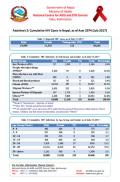What's New
Displaying results 2041 - 2050 of 4914

Guidelines for Managing Advanced HIV Disease and Rapid Initiation of Antiretroviral Therapy: Annexes
Resource | Reviews and Snapshots,
The aim of this review was to determine if packaged interventions, which include enhanced infection prophylaxis, screening, and other elements of care delivered together, can improve outcomes in HIV-positive patients presenting with advanced disease.

Resource | Guidelines,
This publication provides guidance on the public health response to pretreatment HIV drug resistance (HIVDR) to non-nucleoside reverse-transcriptase inhibitors (NNRTIs) among people without prior antiretroviral (ARV) drug exposure or people with prior ARV exposure who are initiating or reinitiating first-line antiretroviral therapy (ART). It also provides the consensus prevalence or threshold of pretreatment HIVDR to NNRTIs at which specific public health actions are triggered. This publication is a supplement to Chapter 4 of the 2016 WHO consolidated guidelines on the use of antiretroviral drugs for treating and preventing HIV infection (2016 WHO consolidated ARV guidelines).
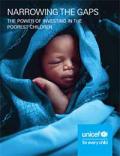
Resource | Publications,
This report provides compelling new evidence that backs up an unconventional prediction UNICEF made in 2010: The higher cost of reaching the poorest children with life-saving, high-impact health interventions would be outweighed by greater results.
This new study combines modelling and data from 51 countries. The results indicate that the number of lives saved by investing in the most deprived is almost twice as high as the number saved by equivalent investment in less deprived groups.

Resource | Publications,
This report aims to provide an overview of the central issues debated and discussed during this important drug control forum. With the intention of incorporating many of the human dimensions lost in more formal records of the meeting, this report includes coverage of the now regular NGO dialogues with representatives from the core UN drug control bodies and the ever-increasing number of side events. Further, in attempting to go beyond a basic descriptive account, it offers some analysis of key topics of debate, as well as emphasizing emerging issues of interest and reoccurring themes. Where appropriate, comparisons are also drawn with previous CND sessions as a means of assessing progress and continuity (or otherwise) within particular issue areas.

Resource | Publications,
The current study explored the association between knowledge about HIV and discriminatory attitudes toward people living with HIV in Pakistan. The incidence of HIV among high-risk groups in Pakistan has reached 5% or higher, indicating a concentrated epidemic. However, little evidence is available about the attitudes of the general population toward people living with HIV. People living with HIV fear being stigmatized and anticipate discriminatory behavior from health care providers and the general community. Having incorrect knowledge about HIV leads to more discriminatory attitudes.
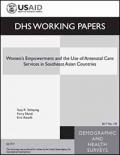
Resource | Publications,
This study assessed the relationship between women’s empowerment and the use of antenatal care (ANC) services in five Southeast Asian (ASEAN) countries. The data used in the study are from the most recent Demographic and Health Surveys (DHS) conducted in Cambodia (2014), Indonesia (2012), Myanmar (2016), the Philippines (2013), and Timor-Leste (2009).
The focus of the analysis was on currently married women who gave birth within the last 5 years before the survey. The two main outcomes were the number of ANC visits they made (four or more compared with none to three), and the timing of the first ANC visit (within the first trimester or later in the pregnancy).
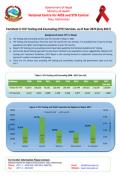
Resource | Fact Sheets,
Background about HIV Testing and Counseling (HTC) in Nepal:
- HIV Testing and Counseling service was first started in Nepal in 1995.
- HIV Testing and Counseling is the entry point for overall HIV care services. It is provided free of cost to the key populations at higher risk and general population all over the country.
- Nepal’s HIV testing and counseling services have been guided by the National Guidelines for Testing.
- Community based testing approach has also been initiated in key population and as suggested by National HIV Testing and Treatment guidelines, 2017 Nepal is also moving forward to implement community led testing to approach in order to maximize HIV testing.
- There are over 175 service sites providing HIV testing and counseling, including 136 government sites as of July 2016.
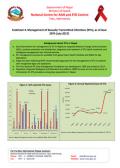
Resource | Fact Sheets,
Background about STIs in Nepal:
- Key interventions for management of STI in Nepal are targeted Behavior Change Communication (BCC), condom promotion and distribution, diagnosis and treatment of STIs (both syndromic and etiological management) and referral services.
- STI management services are available from government health facilities and NGOs for key population.
- Nepal has been following WHO recommended approach for the management of STIs in patients with recognized signs and symptoms.
- The first National STI Case Management Guidelines was developed in 1995 and revised in 2014.
- Repeated Integrated Biological and Behavioral Surveillance (IBBS) Surveys are the main source of information for STI prevalence among key population in Nepal.

Resource | Fact Sheets,
Background about ART program in Nepal:
- ART service started from February 2004 from Sukraraj Tropical and infectious Disease Hospital, Kathmandu in Nepal.
- ART is available for free of cost for People Living with HIV (PLHIV).
- As of July 2017, there are 68 ART sites and 25 ART Dispensing Centers (ADCs) throughout the country.
- ADCs are established to increase accessibility to the treatment.
- Nepal has also adopted Test and Treat approach since Feb 2017.
- National Consolidated Guideline for Treating and Preventing HIV in Nepal 2014 and revised in 2017 is the guiding document for providing HIV treatment and care in Nepal.
- CD4 count service is available from 30 sites and across the country.
- Viral load testing service is available from National Public Health Laboratory






